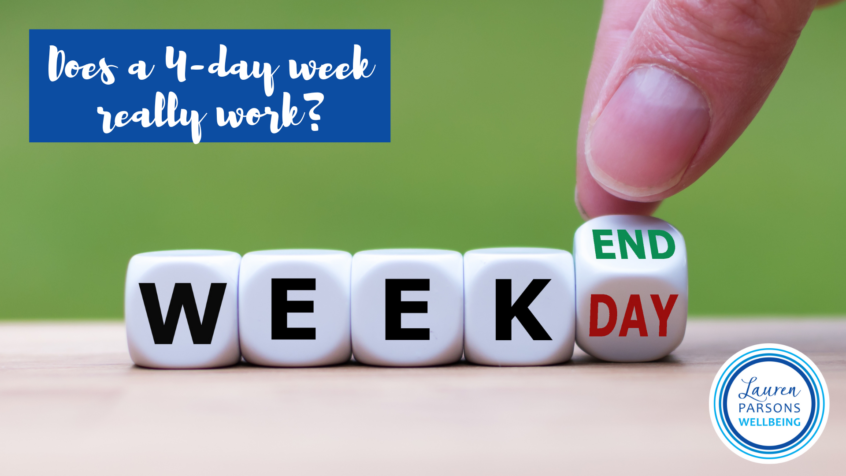An article by Getting a Grip founder, Robyn Pearce.
Have you seen some of the media about the 4-day week that Perpetual Guardian, a New Zealand financial services company, experimented with in 2018?
Their CEO Andrew Barnes and his partner Charlotte Lockhart are personal friends, so it’s been a great chance to get an insider view of the company’s learnings, observations and next steps.
So, what about this 4-day working week? Does it really work?
The answer is a resounding Yes!
Perpetual Guardian started an eight-week trial in March and are now going to install it as a permanent feature, starting in November. Following are some of the key points I gleaned from Charlotte and Andrew in early October.
Set-up and Structure:
- Conversations started with the management team in late January.
- At the beginning of February all staff were given a month to explore, in their teams and with their managers, how they could make it work.
- The trial was not optional. However, what was optional was how they did it. This was an important element. Each team was given freedom to come up with the solutions relevant to their work, rather than arbitrary processes thrust upon them.
- It wasn’t a case of working four x ten-hour days. It was ‘same hours as usual, but if you can find ways to work more efficiently, your reward is an extra day off per week – at full pay.’
- All management were also strongly encouraged to participate.
Results:
- Almost all teams managed to find efficiencies and streamline their work.
- Examples: social media use at work dropped by 35%, there was a 7% reduction in stress, and 78% of employees say they managed their work/life balance better.
- Productivity increased slightly, even though they had less time to get their work done.
- Better staff engagement; they had to work together in order to cover all their commitments. One example was negotiation over which day of the week each person took off. Another was how to manage small regional offices, where some have only two staff. Small offices collaborated with each other so that a senior and more junior person were available via phone and internet for all requests. The location was not the key factor – the service to the customers was.
- New ways of being efficient suddenly became high priority, rather than putting up with slow processes. For example, one woman had previously put up with a clunky process. When a few bright heads got together to trim time off, with better technology they were able to turn a 1½ hour task into a really quick activity taking only ten minutes.
- The firm realised that seasonal pressures meant that, for one team, Trust Accounting, it’s impossible to achieve the four-day target in March/April when most New Zealand businesses have their year-end. The company is working with this team to find a relevant solution to this particular problem.
- Auckland University of Technology and The University of Auckland ran pre- and post- tests to measure productivity. (Perpetual Guardian’s recommendation is, for anyone else considering the same idea, to do the pre-commencement test before announcing that your firm is considering it.) By the time the testers ran the first test, the teams had already begun actively looking for better ways to do things. This independent research was important.
What’s Next:
- The system will be permanently in place by November this year. However, it’s now an individual opt-in. The opt-in is reviewed annually, and the productivity will be reviewed monthly. Each team will manage its opt-ins and its opt-outs and manage the reporting of its productivity.
- The extra day off is a gift that can be taken away, not something that will automatically continue from now as of right.
- The measure is how a team, not an individual, performs. They’re still expected to achieve the same results. The encouragement was, and will continue to be, how to be as effective and efficient as possible, rather than putting up with ‘this is the way we’ve always done it’. So, it’s not bosses applying pressure to perform, but colleagues supporting each other so everyone in the team can get their free day.
- If a team fails to meet their agreed KPIs and loses their day off, the company will work with them to help get back on track.
- Andrew’s initiative has caught the imagination of global media. BBC, CNN, the Guardian, New York Times … and the list keeps growing.
My Observations:
In the twenty-six years since I began working in the field of personal productivity I’ve seen a dramatic shift in ways of work, facilitated by the increased simplicity and decreased costs of international communications. Over-work, stress, increasingly compromised work-life balance – all these are common consequences of the way work is now done.
Every trend eventually forces a reaction. Many individuals and companies have been sucked in by the insidious ease with which work can seep into all our waking hours. Others, more alert to the dangerous trend, have made a conscious decision not to allow work-creep to take over their lives. However, the ones who’ve actively chosen to resist the trend are relatively few; quiet voices trying to be heard in a thunderstorm of societal expectations. For some years thoughtful people around the world have been kicking against this epidemic of overwork. One example is US organisation Take Back Your Time.org. Another is Australian ex-Microsoft VP Daniel Petre, who gained a lot of notice in the late 1990s when he wrote ‘Father Time’, about how dysfunctional work practices disconnect fathers from their families. And now we’ve got a company with a high-profile CEO and the balls to join the movement back to saner work practices.
Have you heard of Lean process improvement?
Basically, it’s the constant search for continuous improvement and a focus on cutting out waste. Most companies link their improvements to improved customer experiences or better rewards for the shareholders. Sometimes there’s also financial rewards to the staff. Typically, however, the worker bees are encouraged to keep beating their wings – just better and faster, not less. Although Perpetual Guardian have applied that thinking, what they’ve done differently is link it to a really attractive reward.
Andrew’s philosophy is: ‘Corporate responsibility doesn’t stop at the factory gate.’ It’s not a new message, but it is very refreshing to find a company and a CEO who put it into practice rather than just mouthing platitudes in corporate mission statements. He wants his staff to be not only great at work, but also great at home and in their communities. Plenty of large corporates invest in giving staff nice benefits, but expect ridiculous hours in return. What Perpetual Guardian has done instead is give their people something money can’t buy – time.
A challenge: If your company could achieve good results with less time at the coal-face, why insist they sit at their desks unnecessarily? Let people have a life and you’ll get better results with people who are fresher, happier and more productive.
This is a bigger conversation than just what one company in the bottom of the world is doing. It is an idea whose time has come.
To all the lateral thinkers/implementers of the world – we need you.
After decades as the Time Queen, Robyn Pearce, CSP has now handed over her Getting a Grip Programmes to her successor – Lauren Parsons, CSP.
These powerful programmes can help you transform your time challenges into high productivity and the life balance you desire. Find out more here.
Download the free report “How to Master Time In Only 90 Seconds”, a simple yet powerful diagnostic tool to help you identify your key areas for action. You’ll find it here.

Share this Post
